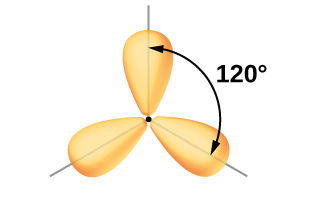The valence orbitals of a central atom surrounded by three regions of electron density consist of a set of three sp2 hybrid orbitals and one unhybridized p orbital. These orbitals form though sp2 hybridization. It involves mixes of one s orbital and two p orbitals, forming a trigonal planar geometry. Rsulting in the formation of three identical hybrid orbitals
For a more correct depiction of sp2 hybridization please check out: Link
Quantum mechanics produces the “plump” orbital lobes. For clarity, we sometimes depict these orbitals in a thinner form and exclude the monor lobes, shown below. These “thinner” representations simplify illustrations by preventing the overcrowding of features. We will adopt this approach whenever the true view becomes too complex to visualize easily.

Borane, BH3, molecule
The observed structure of the borane molecule, BH3, suggests sp2 hybridization for boron in this compound. The molecule adopts a trigonal planar shape, with the boron atom forming three bonds to hydrogen atoms (Figure 2, below). We can compare orbitals and electron distribution in an isolated boron atom in BH3. This comparison is illustrate in the oribtal energy level diagram in Figure 3. The three valence electrons of boron redistribute into three sp2 hybrid orbitals. Note that each boron electron pairs with a hydrogen electron during the formation of B-H bonds.


Any central atom surrounded by three regions of electron density will exhibit sp2 hybridization. This includes molecules with a lone pair on the central atom, such as ClNO, or molecules with two single bonds and a double bond connected to the central atom, as in formaldehyde, CH2O, and ethene, H2CCH2.
